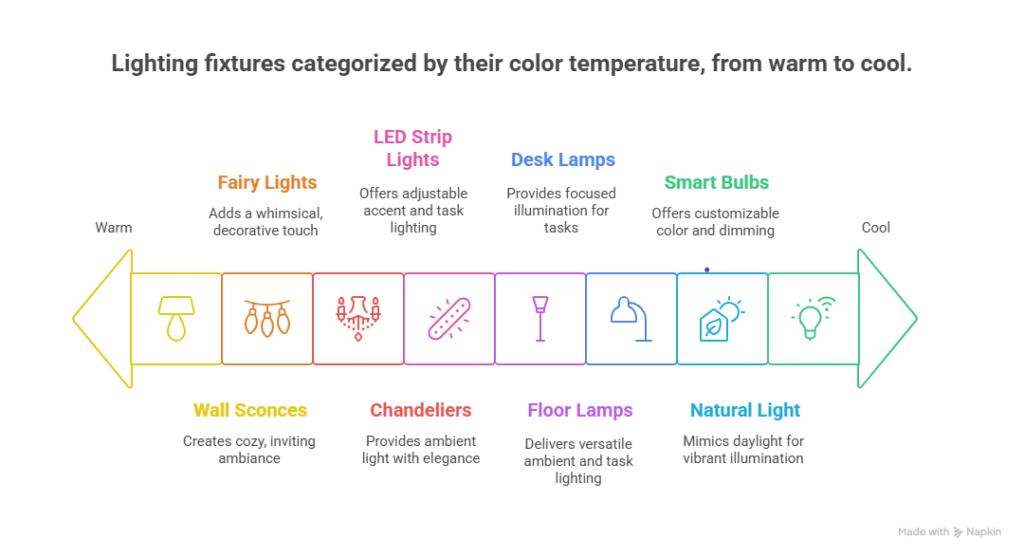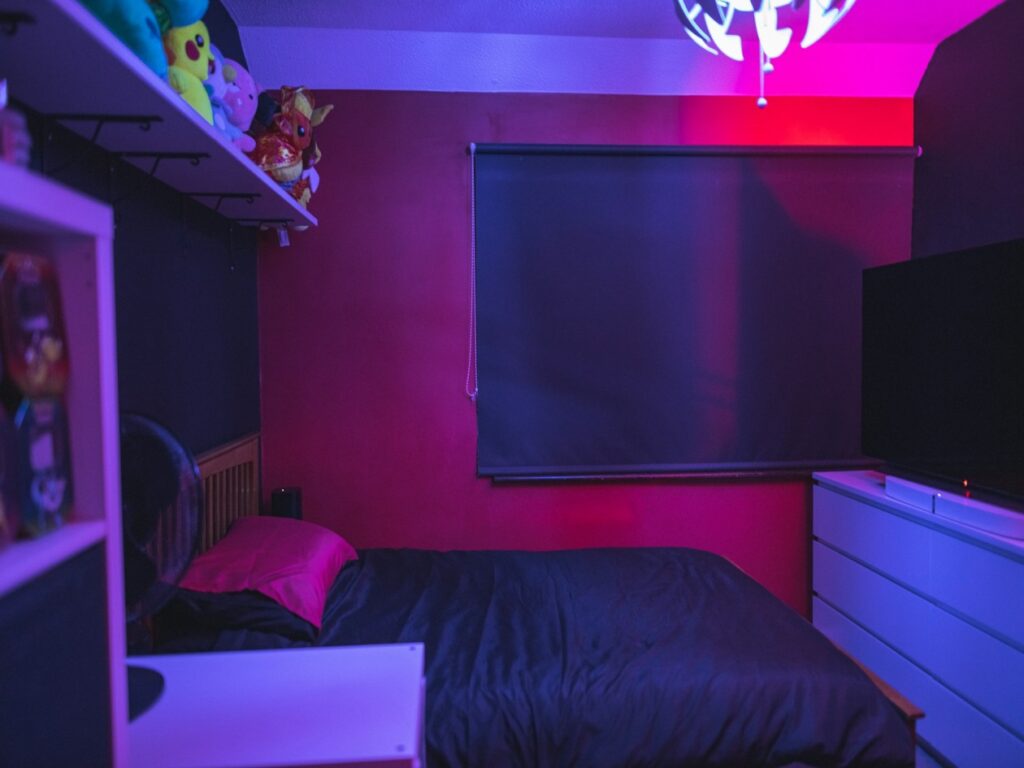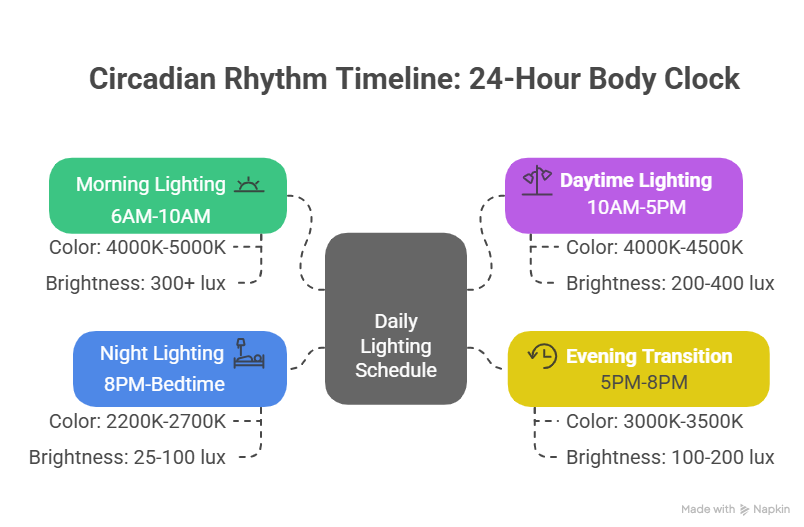Introduction: Why Mood Lighting Matters
Think about your favorite room—what makes it feel special? Chances are, it’s not just the furniture or colors, but the way the light shapes the atmosphere. Lighting isn’t just about seeing—it’s about feeling. The right light can help you relax, focus, or energize, depending on the room and time of day.
This guide introduces seven mood lighting types and shows you how to use them—no complicated setups or expensive renovations required. In this guide, you’ll discover how to use seven types of mood lighting to transform every space in your home, with easy, science-backed tips for every budget.
Table of Contents
Understanding Types of Mood Lighting
Before diving into practical tips for each room, it’s important to know the difference between lighting types and lighting fixtures. This foundation will help you make informed choices as you set up lighting for mood and function:
- Lighting types are about the function—what the light does for your mood or activity.
- Lighting fixtures are the tools you use to achieve that function.
For example, a wall sconce can provide ambient light in a hallway or accent light next to artwork. The same fixture can serve different purposes depending on how you use it.
This table gives you a quick overview of each mood lighting type, its main purpose, and the kind of mood it creates. Use it as a reference to understand which lighting type suits your needs—whether you’re aiming for comfort, focus, or a dramatic effect.
Table 1: The 7 Types of Mood Lighting and Their Purpose
| S.No. | Mood Lighting Type | Primary Purpose | Mood Impact |
| 1. | Ambient Lighting | General Room Illumination as ceiling-mounted LED Panel in living room | Comfort, balance, overall mood foundation |
| 2. | Task Lighting | Focused Lighting for special activities, e.g., reading, Cooking | Productivity, alertness |
| 3. | Accent lighting | Highlighted features or focal points, e.g., a spotlight on wall painting | Visual interest, drama |
| 4. | Decorative Lighting | Adds artistic or design flair, e.g., A crystal chandelier hanging over a dining table | Style, elegance, emotion |
| 5. | Dimmable Lighting | Adjustable brightness for flexible mood control | Adaptability, calmness, personalization |
| 6. | Colour-Chnaging Lghting | Uses RGB or tunable whites to influence mood | Emotional tuning (relaxation to energy) |
| 7. | Natural Lighting | Utilizes natural light sources | Wellness, circadian rhythm support |
Table 2: Popular Fixtures and the Types of lighting They Support
Once you know the mood you want, this table helps you pick the right fixtures. It matches common lighting products with the types of mood lighting they can create, suggests the best color temperatures, and recommends where to use them. This makes it easy to translate lighting theory into real-life choices for your home.
| Lighting Fixture Type | Supports these lighting types | Supports these lighting types | Best for |
| Wall Sconces | Ambient, Accent, Task | Warm White (2700K–3000K) | Hallways, bedside walls, reading nooks |
| Fairy Lights/String Lights | Accent, Decorative | Warm White / Multicolor | Bedrooms, patios, festive decor |
| LED Strip Lights | Accent, Task, Decorative | Tunable (3000K–6500K) / RGB | Under cabinets, shelves, TV backlighting |
| Floor Lamps | Ambient, Task | Warm or Neutral White | Living rooms, bedrooms, corners |
| Chandeliers/Pendant lights | Ambient, Decorative | Warm White (2700K–3000K) | Dining areas, foyers, master bedrooms |
| Desk Lamps | Task | Cool White (4000K–5000K) | Study tables, home offices, workspaces |
| Smart RGB Bulbs and Panels | Color-changing, Dimmable, Decorative | Full spectrum + RGB | Gaming setups, living rooms, teen bedrooms |
| Natural Lights | Natural Daylight | Warm White/Multicolor | Kitchens, offices, indoor plants, wellness areas |
✅ Bonus Tip to Add Below the Table:
💡 Tip: Match the colour temperature to the room’s mood—warmer light for relaxation, cooler light for focus, and RGB or dimmable for versatility and mood-setting flexibility.
Look at the Infographic showing different lighting fixtures with their colour temperature.

Now that you understand the main types of mood lighting, we’ll start with practical tips for each room, then show you how to match lighting to your mood, and finally, how to layer your lighting throughout the day for maximum comfort and wellness.
Room-by-Room Guide Based on Types of mood lighting
Bedroom Mood Lighting
Your bedroom needs warm light. Period!
Research published on ScienceDirect confirms that exposure to high color temperature (cool/blue) light in the evening can disrupt sleep, while exposure to lower (warm) color temperature light is significantly less disruptive.
The Basic Set-up: Primary lighting—warm ambient (2700K)
Set-up: Bedside lamps + dimmable overhead light + accent light behind headboard
Budget: Replace existing bulbs with warm LED bulbs ($15-30)
Upgrade: Fit the bedside lamps with dimmer switches, and get the bedside lamps ($50-80)
Specific mood light options:
• String Lights: The perfect bedroom lighting option. Great for hanging around your headboard, or draping along walls. Battery operated versions are great for renters.
• Fairy Lights: Similar to string lights, but smaller, and more delicate. Great for putting in glass jars or weaving through bed frames. Creates a dreamy, soft light effect without being too bright.
• Colour-Changing Bulbs: Use the red or amber bulbs 2 hours before sleep. While you want to avoid blue and green light at night, purple can be romantic mood lighting, and you can switch to warm white for actually falling asleep.
• LED Strip Lights: Mount them behind the headboard or under the bed frame. They create a ‘floating’ light effect. The light will be low intensity, so you can get up in the middle of the night without turning on high-intensity light.
Place bedside lamps at eye level when you are sitting in your bed. This avoids glare and allows for consistent light across the bed.

Living Room Mood Lighting
Layered lighting is necessary in living spaces. Just having a single overhead fixture in a room makes the space feel flat and uninspired.
Basic setup:
• Overhead dimmable fixture that can be dimmed down for general lighting
• Two, or three table/floor lamps for ambient warmth
• Wall sconces or picture lights for accent
Specific mood light options:
- String Lights: Put them up around windows, doorways, or tuck around furniture. Similar to the warm glow of a cozy cafe.
- Color-Changing Bulbs: Fun option for parties or movie nights. Warm colors (red, orange, yellow) are intimate colors that are good for casual hangouts. Avoid bright blue and green color for night socialising.
- Fairy Lights: Wrap them around plants, bookshelves, or artwork. Battery-powered ones are nice because they give you more options.
- LED strip lights: Incredibly handy to put behind your TV to ease eye strain on movie nights. Also considering putting LED strip lights under shelves or cabinets for more indirect accent lighting.
- Candle-style bulbs: Great for chandeliers or pendant lights. Gives off a warm, flickering light that feels like real candles but is safer and more convenient
- I like to stick to 2700K-3000K, as the warmer tones create a cozy, inviting atmosphere that helps people feel more relaxed and social. Research shows that warm, dim lighting can enhance mood and encourage social interaction.

Kitchen Mood Lighting
Kitchens can be confusing. You need bright light to prepare food but warm light when you eat.
Basic Setup: The answer is lighting in two zones:
• Task areas, such as under-cabinet LED strips at 4000K for food prep
• Eating areas, such as pendant lighting at 3000K hung above islands or tables
Specific Mood Lighting Options:
Under-Cabinet LED Strips: These are essential for task lighting in kitchen. Under-cabinet strips in a bright white (4000K) range are appropriate when preparing food. These can also be dimmable to lower the brightness during an actual meal to get the appropriate amount of ambience.
Pendant String Lights: Hanging pendant string lights over a breakfast bar or island creates a forbidden eatery feel. Use Edison-style bulbs to give the warm, vintage look.
Color-Changing Accent Lights: Small lights installed in toe-kick areas or on shelving can help set the mood for meals. During dinner parties, use warm colors.
Fairy or tinsel lights: These are an excellent choice for display cabinets featuring china or glassware. They create a charming, restaurant-style showcase effect.
Combining all of these sources gives you function and ambiance. You can prepare a safe meal and then transition to eating in comfort in the same way.
Home Office Mood Lighting
The majority of home offices have bad lighting. The lighting is negatively affecting your productivity.
It has been shown that using cool white light or blue-enriched light (4000K-5000K) improve alertness and cognitive performance compared to warmer lighting, especially for tasks requiring attention and concentration.
Basic Setup: Set up your home office as follows:
• Desk lamp – 4000K-5000K. Set to one side of the desk to eliminate glare in your screen
• Overhead light – Any type with adjustable brightness and neutral white
• Background light – soft ambient lighting that can be on to eliminate eye strain of transitioning from bright screen lighting to dark room light.
Specific Mood Lighting Options:
LED strip lights – Mount them behind your monitor, using neutral white during your work hours, change to warm white when you are ready for your video calls in the evening.
String lights – Mount around the perimeter of your office or the wall with the window for background lighting. Use neutral white during your work hours, when you are on call in your evening meetings increase the brightness for better visibility.
Color changing bulbs – Use blue or cool white light during the times you need intense focus and work. Change to warm white when you are creating or brainstorm ideas.
Set your desk lamp to one side of your computer in front of you—not behind—to avoid shadows on your keyboard
Bathroom Mood Lighting
Your bathroom lighting impacts how you look and feel each morning.
You want bright and even lighting around the mirror. But discontinuous overhead lighting creates shadows under the eyes and nose that have a surprisingly big effect on how you feel and look in the morning.
Better Setup: – One vanities light or two wall scones (3500K) on both sides of the mirror.
Dimmable overhead for nighttime relaxing baths.
Add accent lighting with small LED strips or candles for relaxation.
Specific Lighting Options for Each Mood:
LED Strip Lights: Trick: Mount them behind the mirror for even, shadow-free lighting. You can use daylight white (5000k) for applying makeup — and dim the lights to a warm white for relaxing baths.
Waterproof String Lights: Great around bathtubs or shower areas for a spa-like experience for relaxing evening baths.
Colour Changing Bulbs: This works best used in bright white for morning routines, then changing to warm amber for relaxing evening baths.
Fairy Lights in Frosted Jars: Placing some on your counter or window sill adds soft ambient light, battery-powered works best in captive humid environments like bathrooms.
Mood-Based Lighting Guide
Different activities need different lighting. For quick reference, use this table to match your desired mood with the right color temperature, brightness, and light source. For example, use low, warm light for relaxation, and bright, cool light for energy and focus.
Here’s what works for each mood:
| Desire Mood | Color Temperature | Brightness Level | Best Light Sources |
| Relaxation | 2200K-2700K | Low (25-50 lux) | Table lamps, candles |
| Focus/Work | 4000K-5000K | High (300+ lux) | Desk lamps, overhead |
| Romance | 2200K | Very low (<25 lux) | Accent lights only |
| Socializing | 2700-3000K | Medium (100-200 lux) | Multiple Sources |
| Energy Boost | 5000K | High (500+ lux) | Bright Overhead |
Use this table as your reference. When you want to relax, dim everything down and use warm light. When you need energy, brighten up and use cooler light.
How to Layer Your Lighting Throughout the Day
Here’s where most people mess up. They use the same lighting all day long, ignoring how light affects their mood, focus, and sleep. Your body’s natural rhythm reacts to light, and the wrong light at the wrong time can leave you feeling tired or wired.
Morning Lighting (6 AM – 10 AM)
Goal: Wake up and feel alert Color: 4000K-5000K (cool white) Brightness: High (300+ lux)
Tips: Use bright overhead lights and open curtains. Cool light tells your brain it’s time to be awake. It suppresses melatonin and increases cortisol naturally.
Daytime Lighting (10 AM – 5 PM)
Goal: Stay focused and productive Color: 4000K-4500K (neutral white) Brightness: Medium-high (200-400 lux)
Tips: Maintain bright, even lighting. This is when you do your best work. Don’t dim the lights or you’ll feel sluggish.
Evening Transition (5 PM – 8 PM)
Goal: Start winding down but stay functional Color: 3000K-3500K (warm white) Brightness: Medium (100-200 lux)
Tips: This is transition time. Dim the overhead lights and turn on table lamps. Your body starts preparing for sleep, but you can still be productive.
Night Lighting (8 PM – Bedtime)
Goal: Prepare for sleep Color: 2200K-2700K (very warm) Brightness: Low (25-100 lux)
Tips: Turn off overhead lights completely. Use only bedside lamps, candles, or LED strips. This warm, dim light helps your body produce melatonin naturally.
Follow this pattern and you’ll sleep better and feel more energized during the day.
The infographic below breaks down an ideal 24-hour lighting schedule, showing how color temperature and brightness should shift throughout the day to support your mood, focus, and sleep.

Bringing All Types of Mood Lighting to Life with Smart Tech
Smart lighting technology makes creating all of these different styles of mood lighting simple: using a tap of your finger on your smartphone or your voice to switch between scenes, set schedules automatically, and adjust colors to match your exact mood or activity.
With smart bulbs and systems, you can easily combine ambient, task, accent and color-changing lighting, to create a customized home experience. It has never been easier to layer your lighting throughout the day.
Let smart tech take care of moving you from energizing and cool mornings to relaxing and warm evenings, so your home is always feeling just right.
Conclusion
Keep it simple.
Start by updating one room and make the following changes:
1. Change all your overhead bulbs to dimmable LEDs (2700K for bedrooms, 4000K for offices).
2. Add one table or floor lamp that uses warm light.
3. Install one dimmer switch for your overhead fixture This basic scheme will costs $50-100 and can transform any room immediately.
Once you see the impact, you can go layer it on. But if you only make these three changes, you will better your mood and energy!
If we know what are the types of mood lighting and how to use them and the proper fixtures, then we can change every room and coordinate to suit our needs and moods, very simply and practically.
FAQs
What is mood lighting and why does it matter?
Mood lighting can broadly be defined as how we can use the characteristics of different types of light to create particular feelings, or provide a particular experience, in a space. Mood lighting matters because it has the potential to influence how we feel, how productive we are, how relaxed we are, and even the quality of our sleep.
What types of mood lighting are there?
Generally the types of mood lighting consist of; ambient lighting (general lighting), task lighting (used for focus), accent lighting (used to highlight feature), decorative lighting (for decorative purposes), dimmable lighting (can change brightness), colour changing lights (dynamic effect), natural light (daylight-like).
Can I use smart lighting with my old light fixtures?
Yes! Most smart bulbs and LED strips are designed to fit into standard fixtures. All you need to do is swap your old bulbs for smart bulbs, and then connect the smart bulb to your home Wi-Fi or smart hub.
How do I create lighting scenes for different moods? Using your smart lighting app, you can combine different lighting styles (ambient, task, accent) and set schedules or triggers. For example, a “Movie Night” scene, which dims guide lights and turns on accent lights.
Is smart lighting energy efficient? Yes, smart lighting is generally energy efficient, particularly when using LED technology. You can reduce your energy use even more through scheduling, motion sensors, and dimmable lights.

